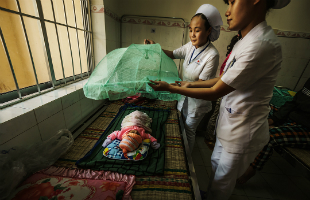
On World Malaria Day (25 April), the World Health Organization (WHO) calls on the government of Viet Nam to accelerate malaria elimination efforts in Viet Nam by 2030.
“WHO, Member States and partners are working together to make sure we have strong systems in place to end malaria in the Region. Joint action will make a real difference for affected communities as the disease burden decreases,” said Dr Shin Young-soo, WHO Regional Director for the Western Pacific.
Viet Nam has made significant progress, achieving as one of ten countries in the Western Pacific Region the targets for malaria reduction under the Millennium Development Goals (MDG). Malaria-related deaths have been reduced by over 90% and prevalence by over 75% in eight out of 10 countries. Last year, Viet Nam recorded 9,331 cases, but only 3 deaths from Malaria.
However, the disease still exerts an enormous toll, not only in lives, but also in medical costs and labour and economic output lost. It undermines the growth and development for millions of people in Viet Nam. Although achievement of MDG-related targets has lowered the malaria burden, the fight against malaria is far from over.
Elimination efforts must accelerate in Viet Nam to ensure that hard-fought gains are not lost. Key to this would be through ensuring that prevention and treatment services are available for all people at risk. Recent cutbacks by major donors have already compelled some countries to scale back on coverage, significantly increasing the risk of malaria resurgence.
Globally, an estimated 3.2 billion people remain at risk of malaria infection, with 1.2 billion at high risk. In the Western Pacific Region, more than 700 million people are still at risk of malaria. This is nearly a quarter of the global population estimated to be at risk. Approximately 41 million of these 700 million are at high risk of malaria infection.
Viet Nam is now largely Malaria free, but it still is disproportionately affecting ethnic minorities and migrant workers, especially in some provinces in the central highlands of Viet Nam. The Greater Mekong Subregion (GMS) as a whole also faces the challenge of multidrug-resistant malaria, affecting Cambodia, the Lao People's Democratic Republic and some parts of Viet Nam.
At the East Asia summit last year, heads of government approved a road map for a malaria-free Asia-Pacific region by 2030. The road map includes the provision of political leadership and sustainable financing necessary to operationalize the WHO Global Technical Strategy for Malaria 2016–2030 within the Asia-Pacific Region.
Since the development of the Greater Mekong Subregion Malaria Elimination Strategy for 2015–2030, GMS Member States have completed updating and aligning their national strategic plans, aimed at rapidly eliminating drug resistant Plasmodium falciparum.
Strategic direction for accelerating control and elimination
The WHO Global Technical Strategy for Malaria 2016–2030 (GTS) includes the following three pillars for accelerating control and elimination:
- universal access to malaria prevention, diagnosis and treatment interventions
- accelerating efforts towards elimination and attainment of malaria-free status
- the transformation of malaria surveillance into a core intervention.
The GTS also identifies the following two enabling factors:
- harnessing innovation and expanding research; and
- strengthening enabling environment.
Working together we can End malaria for good, the theme for World Malaria Day 2016 which captures our common vision for a malaria-free world.
